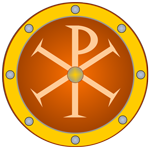
Battle of Preslava(Battle of Zygos pass) |
year: 1053 |
| A defeat of the Byzantines by the Pechenegs in an ambush and a heroic rescue of a unit under Nikephoros Botaneiates | ★ ★ ★ ★ ★ |
|
enemy: Pechenegs
|
location: At a mountain pass south of Preslav in NE Bulgaria (exact location unknown)
|
accuracy:
●●●●●
|
|
battle type: Ambush |
war: Pecheneg Wars |
modern country:
Bulgaria |
| ▼ The Byzantines(emperor: Constantine IX Monomachos) | ▼ The Enemies | |
| Commander: | Michael & Basil Synkellos | Khan Tyrach |
| Forces: | ||
| Losses: |
| Background story: |
| After 1051 and the unexpectedly heavy losses suffered in Charioupolis, the Pechenegs greatly reduced their raids. But they were still a serious threat, while a big problem for Byzantium was that they had occupied a large part of Bulgaria, which a few years ago, in 1018, had become a Byzantine territory. Despite the enormous devastation the Pechenegs had caused throughout the northern Balkans, it seems that they had not made much effort to besiege and occupy large cities. However in 1053 the Pechenegs under khan Tyrach captured Great Preslava in northeastern Bulgaria. The city was the old capital of the Bulgarians and was in the hands of the Byzantines since 1001. Emperor Constantine IX Monomachoss decided to send an army to take back the city. |
The Battle: |
 Ruins of Preslava The Byzantine army crossed the mountain range of Aimos and besieged Great Preslava. The city had strong walls and the Pechenegs were able to defend it successfully. After some time, the Byzantines were forced to end the siege due to lack of supplies. It is believed that the man who was in favor of the decision to lift the siege was Basil Synkellos, who did not want Michael to take the credit for a victory in Preslava. Khan Tyrach foresaw or was informed about the departure of the Byzantines and sent detachments to guard hiden all the passages to the south. The Byzantine army chose to cross a narrow passage of Mount Zygos (the exact location is unknown), where it fell into the ambush of the Pechenegs. Many Byzantines were killed and among them was Basil Synkellos. Michael managed to escape. A unit of the Byzantine cavalry was trapped there, but under the leadership of Nikephoros Botaneiates managed to regroup and escape from the initial ambush. Botaneiates persuaded his men not to run, but to remain disciplined and in formation against the enemy. They were soon surrounded by the Pechenegs who showered them with arrows but seeing that the Byzantines were not breaking formation and waiting for them in a solid array, they retreated. At night, the Byzantines crossed the river behind them trying to run away from the enemy; the next day the Pechenegs surrounded them again and attacked, without being able to break the Byzantine lines this time either. The unit continued to move cautiously and slowly to the south under the constant attacks of the Pechenegs. The Pechenegs shot the horses from under the Byzantines, who then continued on foot. The march continued in this way, under the relentless pursuit of the Pechenegs and with constant fighting, day and night. The Pechenegs attempted to break the formation of the Byzantines during this manoeuvre multiple times, but every attempt was unsuccessful. Nikephoros remained with his men the entire time, even when he was offered a horse to escape. Nikephoros was able to hold his company together for eleven days despite constant attack. Finally they reached Adrianople and the pursuing Pechenegs retreated. |
Noteworthy: |
| The heroism of Botaneiates in Zygos pass is reported only by one historian, Michael Attaleiates, who during the reign of Botaneiates had taken the high office of Vestes. According to a theory, Attaleiates exaggerates in his narrative in favor of his benefactor. Nevertheless, the story is probably true, because in the aftermath Botaneiates was rewarded with high positions and in the end he ascended the throne. |
Aftermath: |
| Shortly after this failure, in the middle of 1054, the Byzantines persuaded (paying generously) the Pechenegs to make peace. This peace, beyond all expectations, lasted many years. The Pechenegs reappeared as a threat in the late 1080s. Nikephoros Botaneiates gained great fame and was awarded the title of magistros; in a relatively old age, he made a career in the highest positions in the army. In 1078 he became emperor. |
|
|
